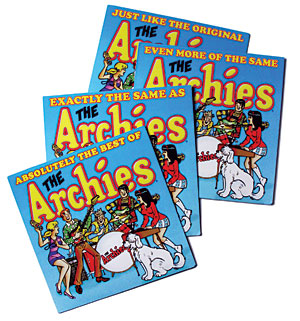If a client asks you to imitate yourself, is that the sincerest form of flattery?
If you ever think that the architecture business has gotten too tough, you can always lay down your mouse, pick up a guitar, and go into pop music. Architects are problem solvers, right? The best make their livings predicting what people need and what will appeal to them. They produce materials lists and instruction sheets, then contractors follow them, a ribbon is cut, and euphoria ensues.

So it shouldn’t be too hard for us to figure out which noises will inoculate young boys and girls with bliss. At most we are talking about three or four minutes of 4/4 time, three chords, and a snazzy backbeat, all of which can be produced with GarageBand, which Apple gives away free with every Macintosh. Yoke up a catchy tune with a few rhyming couplets alternating mania with despair, and next stop, Hitsville.
All you need is one smash and you’ll be set for life. Well, you will be until someone asks you to do another like it. Then you’re back to the quandary every rock ’n’ roller who’s scored big on his first record faces: let your work evolve, like Dylan going electric, which seemed to please nobody, or be remembered as a one-hit wonder who spent the rest of a brief career cloning his or her best effort to meet the demand for more of the same.
All of this came to mind recently when a colleague posted a blog entry on archrecord.com about a new house Richard Meier had designed for the British actor Rowan Atkinson.
Two commentators easily connected the dots between the Atkinson residence and Meier’s 1968 Smith and 1972 Douglas houses: They’re white, have flat roofs and vast areas of glass, and are sited in the middle of nowhere. They are beautiful. But the general tone of the thread seemed to be that we are really entitled to much more from Mr. Meier than a rehash of early work.
Others seemed surprised that Atkinson, who is perhaps best known for his endearingly incompetent character Mr. Bean, hadn’t ordered something more like Pee-wee Herman’s bizarre, visually frantic playhouse (which was extremely interesting and really quite suitable for its purpose, I think). Ummm, but since Rowan Atkinson is not actually Mr. Bean, what they really meant, perhaps, is that the house might have been much more interesting if Mr. Meier’s client actually had been Mr. Bean. As much as I’d like to see what that house looks like, the idea that Richard Meier somehow owes his clients private residences that are different from those he is known to do and does well strikes me as a little unfair.
Joni Mitchell once said to an audience of whiney concertgoers begging her to play their favorite songs, “Nobody ever said to Van Gogh, ‘Paint A Starry Night again, man.’ He painted it, and that was it.” Well, that might have been true where Vincent was concerned, but you don’t go to Richard Meier to get a polka-dotted blue house.
I have admired Meier’s work since 1968, when a copy of Record with the Smith House on the cover arrived at my parents’ home. I was 11, growing up in tract housing, and the Smith House completely changed my view of the world. The Douglas House showed up on the cover of Progressive Architecture a few years later, just after financial difficulties had forced me into architecture school. (My parents refused to fund a journalism major, because though my father subscribed to these journals, he also famously said, “Nobody ever made a living writing magazine articles.”) Work like Meier’s convinced me that the architecture profession was a pretty good second choice.
Many of us in those days tried to design Meier houses of our own, when we weren’t trying to design Graves houses or Gwathmey houses. The halls of my college were jammed with them. Well, most of us got the color right, but that was about it. Sure, you can imitate someone’s work, but the real geniuses in architecture or music or any of the arts leave an inimitable mark on whatever they do. There’s no getting around it.
In 1966, when the Beatles had abandoned bubblegum and were well on their way to “Lucy in the Sky With Diamonds,” a couple of television producers saw an opportunity to pick up where they left off. They pulled four actors together and put Don Kirshner in charge of fabricating music that did kind of sound like early Beatles. The “band” they created, the Monkees, was a sensation. But there’s no way these genetic engineers could have taken “Last Train to Clarksville,” put it into a test tube, and extracted “Back in the U.S.S.R.” from it.
Incidentally, after a year or two, the Monkees dismissed Kirshner. He is said to have decided that he would never put up with actors again. That is why Kirshner’s next group, the Archies, was made up entirely of comic book characters brought to life through the magic of animation. Their sound was created entirely by studio musicians according to his strict formula that was also very successful — if not original.
The industrialized production of buildings by the best and brightest of our profession isn’t new either, of course, and there is no doubt that we long for our idols to surprise us with something new. But their clients have to want that, too. And I don’t feel sorry for them much, because, frankly, they get what they pay for. The people I really feel for are those who labor in obscurity helping their bosses put out these formulaic buildings. What would you call them? No. No. Don’t say it!
Not Archie Architects!

Post a comment to this article
Report Abusive Comment